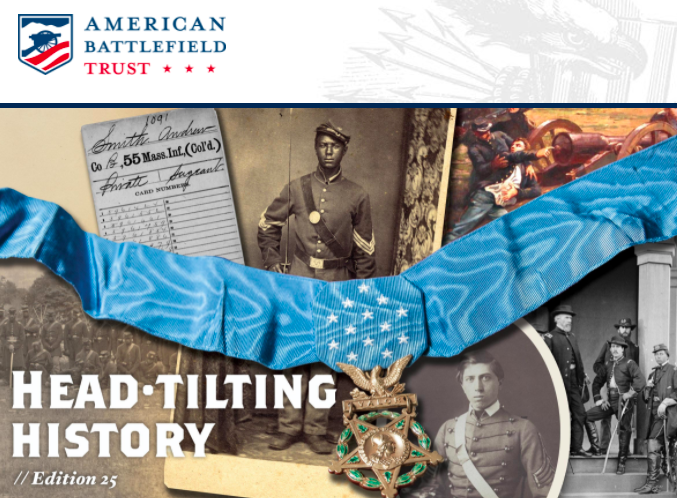Better Late Than Never: Recognizing Above-and-Beyond Valor More Than 100 Years Later
Today revered as the United States’ highest award for military valor in action, the Medal of Honor stemmed from a simpler vision. Iowa Senator James W. Grimes sought a way to uplift morale during the Civil War through the presentation of “medals of honor” to enlisted seaman and marines who “distinguish[ed] themselves by gallantry in action and other seamanlike qualities.” The Navy’s Medal of Honor was established in December 1861, and the Army’s followed in July 1862. By March 1863, Army officers were made eligible, but Naval and Marine Corps officers had to wait until 1915. The first Medals of Honor were presented to a group of six soldiers on March 25, 1863 — a date that officially became National Medal of Honor Day in 1990.
Despite the years-long twists and turns of Congress altering qualifications — particularly time restraints — for awarding the great honor, two Civil War soldiers received the Medal of Honor more than 100 years later: Cpl. Andrew Jackson Smith and 1st Lt. Alonzo Cushing.
After escaping slavery in Kentucky, Smith happened upon a military path — first as an unarmed body servant with the 41st Illinois and then as an enlisted soldier in the 55th Massachusetts Volunteer Infantry Regiment, the sister regiment of the “Glory”-bound 54th Massachusetts. By the summer of 1864, Smith was in combat in South Carolina. But his bravery in battle met its peak during the November 30, 1864, Battle of Honey Hill. It was there that he saved and carried the 55th’s flag after the color sergeant was killed, exposing himself to heavy fire to ensure that his regiment’s colors weren’t lost to the enemy.
Initially nominated for the Medal of Honor in 1916 by a white surgeon who served with him in the 55th Massachusetts, Smith was denied the honor in January 1917 after the War Department performed a meager two weeks of research. But Smith’s daughter, Caruth Smith Washington, never forgot her father’s legacy. The quest for the medal was shared with Smith’s grandson, Andrew Bowman, through several story-filled documents that Smith had handed down. Traveling to battlefields, museums, courthouses and historical societies, Bowman spent years gathering a slew of testimonies to prove his grandfather’s heroics. Smith was again nominated, with U.S. Rep. Thomas W. Ewing (R-IL) reviving the effort in Washington. In 2000, Congress passed a bill that allowed Smith to be awarded the honor, removing the statutory time limit in special cases. On January 16, 2001, President Clinton posthumously presented Smith’s Medal of Honor to Andrew Bowman and Caruth Smith Washington, stating “sometimes it takes this country a while, but we nearly always get it right in the end.”
Today, you can see Smith’s Medal of Honor on display at the Abraham Lincoln Presidential Library and Museum in Springfield, Ill. You can also find the 55th Massachusetts's regimental colors at the Concord Museum in Concord, Mass.
Originally born in Delafield, Wis., Alonzo Cushing and family moved to Fredonia, N.Y. six years later. He graduated from West Point in 1861 and entered into service for the Union, becoming a skilled artillery officer in the Army of the Potomac. Cushing saw action at First Manassas, Fredericksburg and Chancellorsville before his final battle at Gettysburg. On the third day of the battle, July 3, 1863, Cushing commanded 126 men and six cannons positioned on Cemetery Ridge. The devoted 22-year-old was in the direct line of fire during Pickett’s Charge, and despite being struck in the shoulder — and later, devastatingly struck in the abdomen — Cushing refused to leave the field. Held upright by Sgt. Frederick Fuger, who relayed his orders, Cushing was again hit by a bullet in the mouth and fell at the foot of his gun.
In 1987, Margaret Zerwekh began a long journey to recognize the above-and-beyond valor Cushing displayed during the famous Pickett’s Charge at Gettysburg. Though not related by blood, Zerwekh was a historian from Cushing’s hometown of Delafield, Wis., who became invested in his story after discovering that she was living on property once owned by the family. After a decades-long campaign appealing to local, state and federal officials — and even Hollywood — she finally got the attention of U.S. Sen. Russ Fiengold (D-WI). On November 6, 2014, President Obama posthumously presented Cushing’s Medal of Honor to his cousin twice removed, Helen Loring Ensign.
You can visit the National Civil War Museum in Harrisburg, Pa., to see the blood-splattered belt Cushing wore at Gettysburg. As an alternative, take a look at this video from the Trust highlighting the belt, and its journey back to the spot where its wearer fell.
